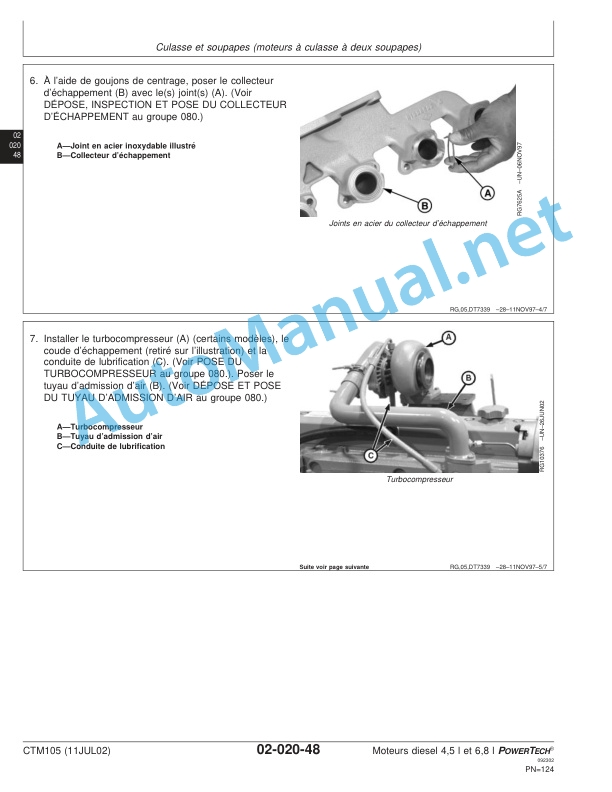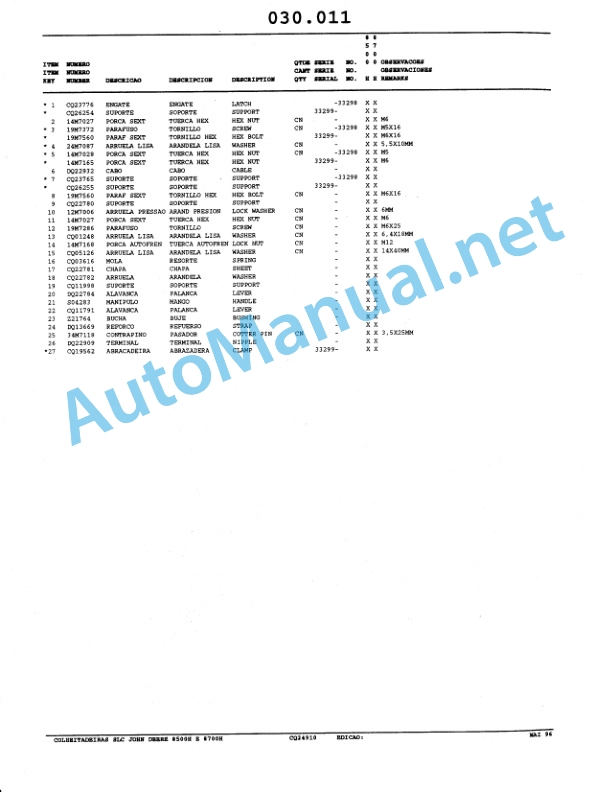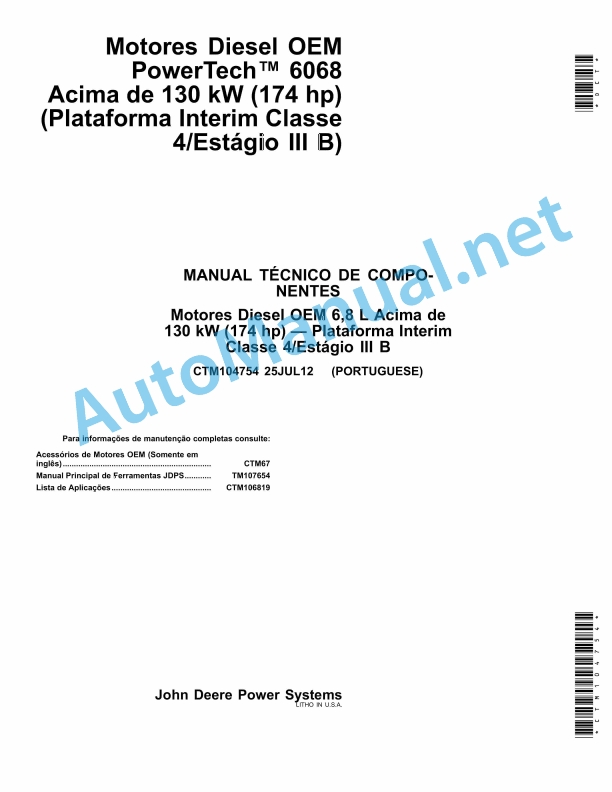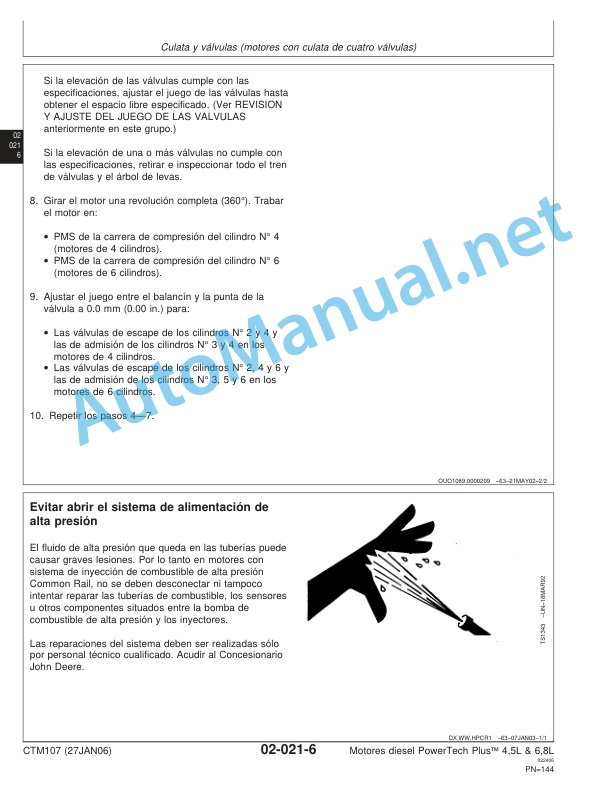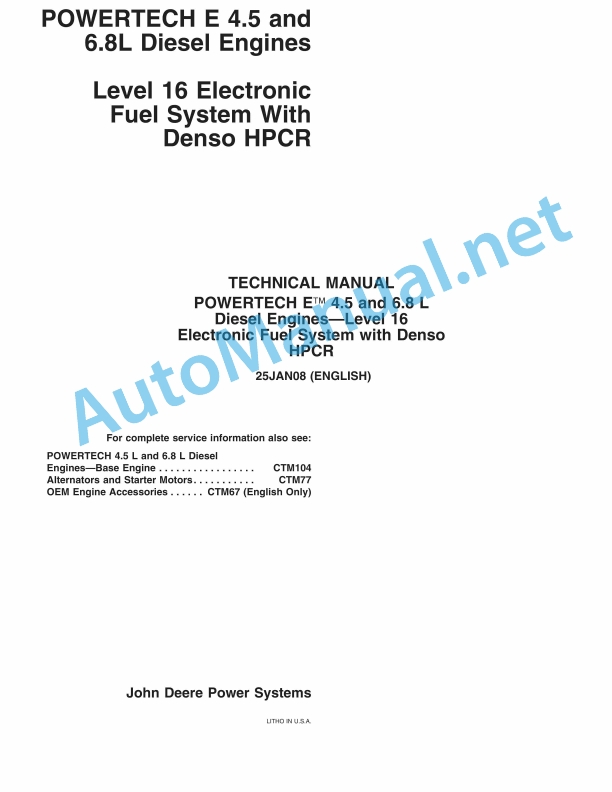Claas Lexion 570 Cat (574) Combines Operator Manual FR
$50.00
- Model: Lexion 570 Cat (574) Combines
- Type Of Manual: Operator Manual
- Language: FR
- Format: PDF(s)
- Size: 42.6 MB
File List:
00 0294 643 1.pdf
00 0294 643 1.pdf:
Contents
1 Introduction
1.1 General advice
1.1.1 Use of the instructions
1.1.2 Validity of the notice
1.1.3 California Proposition 65 Warning
1.1.4 CLAAS Omaha product identification number
2 Safety Tips
2.1 Safety information
2.1.1 Important
2.1.2 Conformity of use
2.1.3 Marking of warnings and dangers
2.1.4 Safety advice and safety stickers
2.1.5 Position of adhesive safety labels
000 515 291 1
000 515 280 0
000 514 930 2
000 514 545 1
000 514 545 1
000 514 545 1
000 514 545 1
000 514 545 1
000 515 293 0
000 514 542 2
000 515 282 0
000 515 289 0
000 516 578 0
000 516 580 0
000 515 292 0
000 515 287 0
000 515 283 0
000 515 283 0
000 515 288 0
000 515 290 0
000 514 544 1
000 515 285 0
000 515 286 0
000 515 281 0
000 514 961 0
000 515 335 0
000 516 544 0
000 516 546 1
000 514 038 2 (1)
000 515 455 0
000 514 551 1
2.1.6 General danger instructions
2.1.7 Compressed air and water
2.1.8 Residual pressure
2.1.9 Hydraulic fluid poses a risk of injury
2.1.10 Liquid recovery
2.1.11 Information regarding asbestos
2.1.12 Dispose of waste in accordance with current regulations
2.1.13 Place the safety support in the supply channel
2.1.14 Remove the safety support from the supply channel
2.1.15 Place the safety support in the reel
2.1.16 Remove the safety supports from the reel
2.1.17 Additional remarks
2.1.18 Avoid burns
2.1.19 Coolant
2.1.20 Oil
2.1.21 Batteries
2.1.22 Battery cut-off switch
2.1.23 Lifting the machine using jacks
2.1.24 Load the machine and secure it
2.1.25 Fire and explosion prevention
2.1.26 Fire extinguisher
2.1.27 Ether
2.1.28 Pipes, tubes and hoses
2.1.29 Position of fire extinguishers
2.1.30 Tire information
2.1.31 Avoiding personal injury in the event of a storm
2.1.32 Ascent and descent
2.1.33 2nd exit
2.1.34 Before starting the engine
2.1.35 Start the engine
2.1.36 Before operation
2.1.37 Before the machine is first put into service
2.1.38 Operation
2.1.39 Driving on the road
2.1.40 Park the machine
3 Technical characteristics
3.1 Overview
3.1.1 Machine details
3.1.2 Double key
3.2 General advice
3.2.1 Conversion factors
3.3 CAT LEXION 570
3.3.1 Cutting deck
3.3.2 Threshing bodies
3.3.3 Separation
3.3.4 Cleaning (standard cleaning system)
3.3.5 Grain recovery
3.3.6 Motor
3.3.7 Chassis
3.3.8 Tires and inflation pressures
3.3.9 Wheel bolt tightening torque
3.3.10 Lane
3.3.11 Road position/working position
3.3.12 Safety devices
3.4 System descriptions
3.4.1 Power supply
3.4.2 Threshing bodies
3.4.3 Separation
3.4.4 Cleaning
3.4.5 Grain recovery
3.5 Nameplate / serial number
3.5.1 Nameplate
3.5.2 Machine number
3.5.3 Engine number
CATERPILLAR C-9
3.5.4 Emission sticker
Emission sticker
3.5.5 Nameplate – straw chopper
3.5.6 Cabin serial number
4 Before commissioning
4.1 General advice
4.1.1 Checklist for initial commissioning
4.1.2 Load the machine and secure it
4.2 Cabin
4.2.1 Cabin with automatic air conditioning
4.2.2 Automatic air conditioning
4.2.3 Commissioning the air conditioning automation
Self-test of the automatic air conditioning system
4.2.4 Adjusting the temperature in the cabin
4.2.5 Manual adjustment of fan-evaporator speed
4.2.6 Connecting the ECON service
4.2.7 Disconnecting the ECON service
4.2.8 REHEAT operation (fogged windows)
4.2.9 Display of the outside temperature
4.2.10 Switching the temperature display to ˚Fahrenheit
4.2.11 Heating the foot area
4.2.12 Fault display – F0 temperature sensor error (passenger compartment, blue)
4.2.13 Fal display – F1 temperature sensor error (blown air, yellow)
4.2.14 Fault display – F2 temperature sensor error (external, red)
4.2.15 Cabin with air conditioning (Standard model)
4.2.16 Commissioning the air conditioning
4.2.17 Heating
4.2.18 Heating the foot area
4.2.19 REHEAT operation (fogged windows)
4.2.20 Failure, possible cause or solution – air conditioning
4.2.21 Refrigerated compartment
4.2.22 Refrigeration unit (optional)
4.2.23 Cooler (optional)
4.2.24 Ice cube tray (optional)
4.2.25 Windshield washer device
4.2.26 Harvest control
4.2.27 Opening and closing the cabin roof
4.2.28 Cabin emergency exit
4.2.29 Overview of the driving position with mechanical driving control
4.2.30 Control console with mechanical driving control
4.2.31 Screen (machine progress screen)
4.2.32 Screen (harvest screen)
4.2.33 C button area / D selector
4.2.34 Ignition lock
4.2.35 Multifunction switch
4.2.36 Driving informant
4.2.37 Multifunction handle
4.2.38 Reel height limitation
4.2.39 Changing position of the steering column
Pivot the steering column downwards forward
Pivot the steering column downwards towards the rear
Swivel the steering column up
4.2.40 Steering wheel height adjustment
4.2.41 Ag Leader® Technology
4.2.42 Ag Leader guideline values for pulses per 100m (328.08ft)
4.2.43 Power plant
4.2.44 Summary – central electrical system (up to machine No. …)
4.2.45 Engine status indicator light
Discontinuous motor error
4.2.46 Fuses
4.2.47 Relays
4.2.48 Driver’s seat
4.2.49 Driver’s seat on air cushion
Right armrest adjustment
Seat depth adjustment
Seat tilt adjustment
Horizontal adjustment of the driver’s seat
Height adjustment
Weight adjustment
Adjusting the tilt of the left armrest
Lumbar support
4.2.50 Seat belt
4.2.51 Adjusting the seat belt
4.2.52 Unfasten the seat belt
4.2.ngthe seat belt
4.3 Lighting and power sockets
4.3.1 Driving lights, working lights, mirrors
4.3.2 Sidefinder (optional)
4.3.3 Exit lighting
4.3.4 Positioning of reversing lights
4.3.5 12 V female sockets
4.3.6 CDS 5000 diagnostic connection female socket
4.4 Side hatches
4.4.1 Opening and closing the side hatches and the rear hatch
4.4.2 Open the rear hatch
4.4.3 Adjust the height of the side hatch handle
4.4.4 Adjust the closing of the side hatch
4.4.5 Tool cabinet
Safety sticker (0516 275.1)
4.5 Wings
4.5.1 Installation of the wings
4.6 Steering axles
4.6.1 Overview of steering axles
4.6.2 Shift the drive axle 000 694 466 4 from the road transport position to the working position
4.6.3 Adjusting the drive axle 000 694 466 4 to the track
4.6.4 Drive and steering axle 000 694 491 2 modification to move from transport position to working position
4.6.5 Drive axle and steering 000 694 491 2 track adjustment
4.6.6 Move the steering axle 000 770 172 0 from the road transport position to the working position
4.6.7 Steering axle 000 770 172 1 – adjust track
4.7 Cutting deck hydraulic cylinders
4.7.1 Hydraulic cutting deck cylinders without spring
4.7.2 Filling the pressure accumulator for CLAAS AUTO CONTOUR II
4.8 Twin wheels
4.8.1 Install the dual wheels
4.9 Hopper
4.9.1 Close the hopper flow openings
4.10 Driving the CAT LEXION 570 / 560 combine harvester with mechanical forward control
4.10.1 General, driving the combine harvester
4.10.2 Rotary engine speed selector
4.10.3 Average engine idle speed
4.10.4 Start the engine
4.10.5 Forward / Reverse
4.10.6 Changing gears
4.10.7 Adjust the flexibility of the forward lever
4.10.8 Shutdown
4.10.9 Machine driving characteristics
4.10.10 Driving characteristics with cutting deck trailer
4.10.11 Management
4.10.12 Couple/uncouple the brake pedals from the service brake
4.10.13 Brake pad wear display (up to machine number …)
4.10.14 Parking brake
4.10.15 Stop the engine
4.10.16 On / Off system 4 Trac CLAAS
4.10.17 Towing the machine
4.10.18 Forward towing
4.10.19 Towing in reverse
4.10.20 Machine serial numbers for the process of shifting gears in EHS emergency mode using the gear button
4.10.21 Shift process in EHS emergency service using the gear button (from year of construction October 2006)
4.10.22 Emergency control sticker – electro-hydraulic coupling (EHS)
4.10.23 Mechanically shift the neutral position on the gearbox
4.10.24 Restore initial state (gearbox can be shifted electro-hydraulically again)
4.10.25 Shift the neutral position on the hydraulic gearbox
4.10.26 Shift hydraulically to 2nd gear
4.11 Autopilot CLAAS (Maize header)
4.11.1 Commissioning the CLAAS Autopilot
Safety disconnect device:
4.12 Autopilot CLAAS (grain cutting deck)
4.12.1 Adjusting the rectilinear movement of the combine harvester
4.12.2 Adapt the laser sensor to the field
4.12.3 Approximate adjustment
4.12.4 Fine adjustment
4.12.5 Laser sensor (grain border out of field of vision)
4.12.6 Adjust the right laser sensor (optional)
4.12.7 Commissioning the CLAAS Autopilot
Safety disconnect device:
4.12.8 Use in rapeseed with left side knife
5 Mount/dismount the front tool
5.1 General warning information
5.2 General assembly and adjustments
5.2.1 Mount the front tool
5.2.2 Dismantle the front tool
5.2.3 Set the cutting angle of the HP feed channel (optional equipment) to the basic position (up to machine No….)
5.2.4 Set the cutting angle of the HP feed channel (optional equipment) to the basic position (from machine No…. to machine No….)
5.2.5 Set the cutting angle of the HP feed channel (optional equipment) to the basic position (from machine No….)
5.3 Workouts
5.3.1 Install the cardan shaft
5.3.2 Dismantle the cardan shaft
5.4 Hydraulics
5.4.1 Mount the multicoupler
5.4.2 Dismantle the multicoupler
5.5 Bodywork
5.5.1 Hanging the front tool
5.5.2 Lock the front tool
5.5.3 Unlock the front tool
5.5.4 Unhook the front tool
6 CEBIS use (Version 9.22)
6.1 CEBIS CLAAS on-board information system
6.2 CEBIS screen and selector
6.2.1 C key field
6.2.2 Rotary selector D
6.2.3 Marking box
6.2.4 Multifunction handle
6.2.5 Screen areas E (harvesting screen)
6.3 Rotary selector D
6.4 Before first commissioning
6.5 Progress screen
6.6 Harvest screen
6.7 CLAAS CRUISE PILOT
6.7.1 Max. speed
6.7.2 Flow zero point
6.8 Yield mapping
6.9 Marking
6.10 GPS
6.10.1 ON / OFF mapping
6.10.2 Mapping indication
6.10.3 Load GPS data
6.11 Reel presets
6.11.1 Horizontal position of the reel
6.11.2 Reel speed
6.11.3 Reel height
6.12 Front tool presets
6.12.1 Gathering tray spacing
6.12.2 Cutting deck, table length
6.12.3 CAC setting
6.13 Partial width command
6.14 Performance measurement device
6.14.1 Components
6.14.2 Basic setting and calibration
6.14.3 Preparing for performance measurement
6.14.4 ON / OFF humidity measurement, humidity correction, storage humidity
6.14.5 Fast way to meaningful measurement data
6.15 Performance measurement
6.15.1 Calibration factor
6.15.2 Yield zero point measurement
6.15.3 Counterweighing
6.15.4 Weighed
6.15.5 Humidity correction
6.15.6 Humidity measurement ON/OFF
6.15.7 Tilt zero point
6.15.8 Storage humidity
6.15.9 Dry product display
6.16 Adjustment according to the harvested product
6.16.1 List of products
Load LEXION values
Load own values
Memorize your own values
Print values
Show LEXION values
Show own values
6.16.2 Cleaning by blowing
6.17 Save
6.17.1 Projected construction sites
Next site
Previous project planned
New planned construction site
Modification of a planned site
6.17.2 Start / Stop
6.17.3 Completed projects
Next or previous site completed
Restarting a completed site
Surface correction
6.17.4 Daily counter
Print the daily meter
Clear the daily counter
6.17.5 Global counter
Print global counter
6.17.6 Product counter
6.17.7 Copying a new PCMCIA card
6.18 Setting
6.18.1 Cutting deck
CAC sensitivity
Cutting height end stops
Partial width levels
Working position
Working width
Reel height automation
Reel height end stops
Cutting deck automation
Reel horizontal adjustment end stops
Header plate end stops
6.18.2 Diets
Learn diets
Learn the max speed. empty
Belt slippage
Bale Spreader Monitoring
RPM monitoring of the grain elevator
6.18.3 Tachometer
Calibration step
Pulses/100 m
ATP sensitivity
Zero point of the ATP front-end tool
Steering zero point
Signals Autopilot
Advancement strategy
6.18.4 Separation
Testing the sensors
Upper and lower gate end stops
Top or bottom rack adjustment
Potato limit
Zero point removed
6.18.5 CEBIS
Language
Date hour
Pos./neg. display
Units of measurement
Clean display
Telematics service (optional equipment)
6.18.6 Maintenance
XXh work list
6.18.7 Instructions for use
Basic setting
Adjustment aids
Problems/Solutions
Checklist
Safety tips
6.18.8 Save code
6.19 Motor load
6.19.1 Engine diagnosis
6.20 Alarms
6.21 Warnings
6.22 Incident / Solution – Performance measurement device
6.23 Reference values for pulses/100 m
8 Maintenance – basic machine
8.1 Important maintenance tips
8.1.1 Important safety tips and regulations
8.1.2 Front tool
8.1.3 Correct chain tension
8.1.4 Belts
8.1.5 Drives
8.1.6 Bolting
8.1.7 Lubrication
8.1.8 Brakes
8.1.9 Wheels / tires
8.1.10 Hydra system 8.1.11 Electrical system
8.1.12 Air conditioning
8.1.13 Protective devices / Spare parts
8.1.14 Unbalance
8.1.15 Welds
8.1.16 General advice regarding tightening torques
8.1.17 Standard tightening torques for tangent screw clamps
8.1.18 Tightening torque for metric adjustment thread
8.1.19 Tightening torques for fine metric threads
8.2 Maintenance tables
8.2.1 Basic machine maintenance table
8.3 Lubricant tables
8.3.1 Lubricants
8.4 Hydraulic system
8.4.1 Pressure accumulator
8.4.2 Checking the oil level
8.4.3 Hydraulic oil change
8.4.4 Replace the hydraulic oil filter
8.4.5 Saturation of the hydraulic oil filter
8.4.6 Replace the return filter
8.4.7 Filling instructions when changing hydraulic oil
8.4.8 Adjust the hydraulic cylinders for lateral compensation of the cutting deck
8.5 Gearboxes / Brakes
8.5.1 CAT LEXION 580 R / 570 R / 560 R / 570 / 560 gearbox
8.5.2 Bridge gearbox (planetary gear)
8.5.3 Beater speed reduction box
Oil drain
8.5.4 Engine output transfer case
8.5.5 Hopper emptying gearbox
8.5.6 Foot brake and brake fluid
8.5.7 Parking brake CAT LEXION 585 R / 580 R / 575 R / 570 R / 560 R / 570 / 560
8.6 HP power channel
8.6.1 Tensioning the feed chains
8.6.2 Clean the intake ventilation (optional equipment)
8.7 Standard power channel
8.7.1 Tensioning the feed chains
8.7.2 Clean the intake ventilation (optional equipment)
8.8 Elevator chains
8.8.1 Tensioning the grain elevator chains (Machine without yield measuring device)
8.8.2 Tensioning the grain elevator chain (machine with yield measuring device / without ball valve)
8.8.3 Tensioning the grain elevator chain (machine with yield measuring device / with ball valve)
8.8.4 Loosen the grain elevator chain (machine with yield measuring device)
8.8.5 Tighten the grain elevator chain
8.9 Drive belts / drive chains
8.9.1 General advice
8.9.2 Left-hand drive scheme (standard cleaning system)
8.9.3 Right-hand drive scheme (standard cleaning system)
8.9.4 Remove the belt (1)
8.9.5 Install the belt (1)
8.9.6 Remove the belt (2)
8.9.7 Install the belt (2)
8.9.8 Remove the belt (3)
8.9.9 Install the belt (3)
8.9.10 Remove the belt (4)
8.9.11 Install the belt (4)
8.9.12 Remove the belt (5)
8.9.13 Install the belt (5)
8.9.14 Remove the belt (6) (without torque support)
8.9.15 Install the belt (6) (without torque support)
8.9.16 Remove the belt (7)
8.9.17 Install the belt (7)
8.9.18 Remove the belt (8)
8.9.19 Install the belt (8)
8.9.20 Remove the belt (9)
8.9.21 Install the belt (9)
8.9.22 Remove the belt (10)
8.9.23 Install the belt (10)
8.9.24 Remove the chain (11)
8.9.25 Install the chain (11)
8.9.26 Remove the belt (12)
8.9.27 Install the belt (12)
8.9.28 Remove the belt (13)
8.9.29 Install the belt (13)
8.9.30 Remove the belt (14)
8.9.31 Install the belt (14)
8.9.32 Remove the belt (17)
8.9.33 Install the belt (17)
8.9.34 Remove the belt (18)
8.9.35 Install the belt (18)
8.9.36 Remove the belt (19)
8.9.37 Install the belt (19)
8.9.38 Remove the belt (20)
8.9.39 Install the belt (20)
8.9.40 Remove the belt (22)
8.9.41 Install the belt (22)
8.9.42 Remove the belt (45)
8.9.43 Install the belt (45)
8.9.44 Remove the belt (46)
8.9.45 Install the belt (46)
8.9.46 Remove the belt (48)
8.9.47 Install the belt (48)
8.9.48 Remove the belt (51)
8.9.49 Install the belt (51)
8.9.50 Remove the belt (52)
8.9.51 Install the belt (52)
8.9.52 Remove the belt (53)
8.9.53 Install the belt (53)
8.9.54 Remove the belt (54)
8.9.55 Install the belt (54)
8.9.56 Remove the chain (55)
8.9.57 Install the chain (55)
8.9.58 Remove the chain (56)
8.9.59 Install the chain (56)
8.9.60 Adjust the chain (56)
8.9.61 Remove the belt (57)
8.9.62 Install the belt (57)
8.9.63 Remove and install the belt (58)
8.9.64 Remove the belt (59)
8.9.65 Install the belt (59)
8.10 Cabin / Air conditioning
8.10.1 Check the seat belt
8.10.2 Replacing the seat belt
8.10.3 Clean the cabin filter
8.10.4 Clean the parts in the cabin roof
8.10.5 Cleaning the cabin windows
8.10.6 Clean the capacitor
8.10.7 Check the refrigerant level
Function of the floating white ball:
Function of the orange indicator ball
8.10.8 Replace the filter dryer
8.10.9 Filling quantity of refrigerant R 134 a
8.10.10 Oil for the compressor
8.10.11 Maintenance work to be carried out before harvest
8.11 Fire extinguisher
8.11.1 Check fire extinguishers
8.12 Straw chopper
8.12.1 Unscrew the articulated cereal knives
8.12.2 Screw in the articulated cereal knives
8.12.3 Replace the counter knives
8.12.4 Check and replace the straw chopper blades
8.12.5 Check the straw chopper rotor
8.12.6 Replace the straw chopper blades
8.13 Wintering
8.13.1 Winterizing tips for combine harvesters
9 Maintenance – Engine
9.1 Important maintenance tips
9.1.1 Important safety tips and regulations
9.1.2 Coolant and air suction pipes
9.1.3 Coolant
9.1.4 Belts
9.1.5 Clean the engine compartment and hazardous areas
9.1.6 Alternator
9.1.7 Warranties on products not supplied by CATERPILLAR
9.1.8 Authorized engine oils
9.1.9 Engine oils with solid lubricating additives
9.2 S·O·S liquid analysis
9.2.1 S·O·S oil analysis
9.2.2 S·O·S oil sampling
9.3 Maintenance tables
9.3.1 CATERPILLAR C-9 (TIER III) maintenance table
9.4 Lubricant tables
9.4.1 Table of CATERPILLAR C-9 engine lubricants (TIER III)
9.4.2 CATERPILLAR C-9 (TIER III) cooling system lubricant table
9.5 Engine overview
9.5.1 CATERPILLAR C-9 (TIER III) engine overview
9.6 Fuel system / Engine oil
9.6.1 Fuel system
9.6.2 Filling the fuel tank
9.6.3 Bleeding air from the fuel tank
9.6.4 Drain water and deposits from the fnk
9.6. shut-off valve
9.6.6 Water decanter / Fuel pre-filter – Clean/Replace
Exploded view of the fuel pre-filter:
9.6.7 Replacing the fuel filter cartridge
9.6.8 Bleed the fuel system
9.6.9 Checking the engine oil level
9.6.10 Replacing the engine oil and filter
9.6.11 Drain used oil
9.6.12 Oil filter
9.6.13 Filling with engine oil
9.7 Cooling system
9.7.1 Coolant
9.7.2 Drain the coolant from the cooler
9.7.3 Filling the cooler with coolant
9.7.4 Identify coolant quality
9.7.5 Coolant mixing ratio
9.7.6 Replacing the coolant
9.7.7 Stopping an overheating engine
Alarm signal :
9.7.8 Radiator protective grille
Cleaning the radiator cage:
Tilt the radiator cage upwards:
9.7.9 Cleaning the water radiator
9.7.10 Diesel engine failure
9.8 Dry air filter
9.8.1 Warning system
9.8.2 Cleaning the suction grille
9.8.3 Cleaning the air filter
Disassemble the main air filter cartridge
Cleaning the main air filter cartridge
Installing the main air filter cartridge
9.8.4 Security cartridge
9.8.5 Assembly and disassembly of the safety cartridge
9.9 Alternator
9.9.1 Cleaning the three-phase alternator
9.10 Electrical system
9.10.1 Battery
9.10.2 Checking the battery
9.10.3 Recycle the battery
9.10.4 Replace batteries, battery cables or battery disconnect switches
9.10.5 Check the alternator and starter
9.11 Incident, possible cause or solution
9.11.1 Motor
9.12 Wintering
9.12.1 Winterizing tips for engines
10 Lubrication plan
10.1 Lubrication points
10.1.1 Lubrication intervals
10.1.2 Lubrication points – 10 o’clock left side
10.1.3 Lubrication points – 50 h left side
10.1.4 Lubrication points – 50 h right side
10.1.5 Lubrication points – 100 h left side
10.1.6 Lubrication points – 100 h right side
10.1.7 Lubrication points – 500 h left side
10.1.8 Lubrication points – 500 h right side
11 Service Information
11.1 Solution
11.1.1 Air conditioning and heating system
11.1.2 Eliminate faults – Motor
Alphabetical index
Numerics
John Deere Repair Technical Manual PDF
John Deere Repair Technical Manual PDF
John Deere Repair Technical Manual PDF
John Deere 18-Speed PST Repair Manual Component Technical Manual CTM168 10DEC07
John Deere Parts Catalog PDF
John Deere Harvesters 8500 and 8700 Parts Catalog CPCQ24910 Spanish
John Deere Repair Technical Manual PDF
John Deere Repair Technical Manual PDF
John Deere Repair Technical Manual PDF
John Deere Repair Technical Manual PDF
John Deere Repair Technical Manual PDF
John Deere POWERTECH E 4.5 and 6.8 L Diesel Engines TECHNICAL MANUAL 25JAN08






